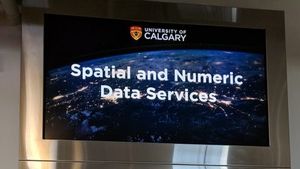NISO organized a meeting on library resource management a couple of weeks ago: I notice that the presentations are now available on the web. They make an interesting collection, and I return to them in a moment.
I have written about the library systems environment in these pages from time to time. A blog entry from Summer 2007 formed the basis of a Portal article [pdf] of the same name (Reconfiguring the library systems environment), which had these pictures:

Libraries manage a variety of materials workflows, each supported by a different systems apparatus. In each case there is a vertical arrangement, as materials are disclosed through discovery and delivery services which in turn relate to backend management services in closely coupled ways. Bought (often print) materials go through an ILS workflow and are disclosed through the catalog which is usually a part of the ILS itself. Systems to manage these materials in resource sharing arrangements may also be present. Licensed materials have an emerging apparatus of management systems support (ERM, knowledgebase, A-Z lists, and so on) and are disclosed in a variety of ways including metasearch and resolvers. A routine approach has not emerged for digital materials and they are managed in a variety of repository and other frameworks, and delivered to per-repository user interfaces. Different approaches may be taken with different categories – digitized special materials, web archives, institutional research materials, and so on – and metadata may be exposed for harvesting. Although not pictured here, one might add that there may also be additional workflows associated with archival materials or special collections. (Slide 4 of Mackenzie Smith’s presentation [ppt] is an interesting depiction of the internal library systems environment showing the range of actual systems supported.)

The complex array of systems – at different stages of maturity and created in quite different technical environments – has encouraged a move towards some rationalization and integration. In particular, we can see a drive to integrate the management workflows across material types. Examples here are OCLC’s Cooperative Webscale Management Systems initiative, Ex Libris’s URM, and the open source OLE project. At the same time, we see two trends on the discovery side. The first is a drive towards deeper integration across types, both through greater use of metasearch and through actual consolidation of files. Althought it will not be comprehensive of all available materials, we will see much more of the latter approach for efficiency reasons. The second is a realization that library resources need to be disclosed more effectively to a variety of other environments, whether they are other institutional systems (e.g. course management) or external.

So, finally I note two major challenges. One is that on the management side libraries have to pull together a variety of systems and services whose legacy business and technical boundaries may no longer map very well onto user requirements. A second is that they have to project their resources into a variety of user environments and workflows over and above whatever integrated local library website environment they create. These include personal (people have a growing variety of ways of finding, saving and collecting information resources), institutional (think of course management systems, student portals, …), and network-level services (search and discovery services; social networking, bookmarking and bibliography sites; …). Related to this is the challenge of integrating community in library services: there is a gap between libraries as inevitably social organizations and the social component of the library experience on the web. A redrawing of this image today would have to include a better sense of user participation.
In this context, here are some incomplete notes on some of the presentations at the NISO meeting:
- General overviews were given by Oren Beit-Arie [ppt] and Marshall Breeding [pptx] in a wide-ranging opening keynote and conclusion respectively. Oren presents a picture not unlike the one suggested above, discussing the need to move from content-based verticals to service-based horizontals. The context for much of what he says is provided by a summary of responses from interviews with librarians. Here are the headline requirements (adapted slightly): a single interface for discovery and delivery of all library/institutional assets; consolidated workflows, uniting traditional library functions with those of the “digital library”; collaboration to increase productivity, leveraging “network effect”; re-use of metadata; SOA-based interoperability; software-as-a-service deployment option; user-provided data. He characterizes evolving services within a traditional/transitional/transformational framework, where traditional involves doing the same thing differently, transitional involves doing new things in support of the transitional, and transformational involves doing new things. Moving services to the cloud is given as an example of the traditional, as is evolution of the cataloging environment; exploiting network effects (e.g. collaborative collection development, tagging of library images in Flickr, ..) is given as an example of transitional; and the mobilization of usage data to transform services (new metrics of scholarly evaluation, recommender systems, analytics and ranking of results) is given as an example of transformational services.
- System sourcing decisions and their implications figure large in the agenda given the recent focus on open source approaches. Marshall Breeding [pptx] cryptically notes ‘many unannounced open source projects’ which may change the current low defection rates from established ILS vendors. How will open source initiatives work with emerging software as a service trends?
- Recommendation and other ways of mobilising usage (or intentional) data figure in several places, in line with general trends. I suggested recently that we will see services which don’t use direct user input in the form of tagging or review, and indirect in the form of usage data to support ranking, relating and recommending, as bleached, rather like black and white TV in a color world. See Kevin Kidd’s presentation [ppt], as well as Oren’s, on this issue.
- Scalar emphasis has become an important question for libraries. At what scale should things be done as institution-scale is increasingly the wrong level for many activities? Oren discusses the transitional effect of the network in broader collaborative settings, where the power of the network can be leveraged to improve services. Shared cataloging and resource sharing may be earlier instances of this. Consider now the potential for recommendations where circulation or other usage data is aggregated at a higher level. Consider incentives also in this context. Where are library users most likely to want to invest their effort? Kat Hagedorn [ppt] discusses a collaborative project of the HathiTrust, New York University, and the partners in the ReCAP shared print facility with the involvement of OCLC Research and CLIR. What policy and service apparatus needs to be in place to provide confidence of supply from HathiTrust and ReCAP sufficient to allow NYU relegate materials from its own collection? Such ‘cloud library’ provision will become more common as libraries seek to transfer resource away from ‘infrastructure’ and towards user engagement. Kyle Bannerjee describes [ppt] Orbis Cascade’s work with OCLC on the integration of local, consortial and global discovery and delivery of resources. He suggests that operations should move to the highest appropriate level in the network, and speculates about what other services should move to the network level. Rachel Bruce [ppt] looks at library systems from the point of view of national-scale ‘shared services’. What these and other presentations show is how decisions about level of operation – personal, local, consortial, national, global – are as important as particular discussions of functionality or sourcing. Libraries face interesting choices about sourcing – local, commercial, collaborative, public – as they look at how to achieve goals, and as shared approaches become more crucial as resources are stretched.
- Academic library systems are part of an enterprise infrastructure, which is discussed here by Mackenzie Smith [ppt] of MIT and Diane Mirvis [pptx] of the University of Bridgeport. For me, these were the most interesting presentations here as they point to a set of influences that are not discussed very often. As more activity takes place on the network, as students, faculty and administrators create and use data from many sources, and as there is more pressure for new types of integration on both user and management side, it will be interesting to see how organizational and system boundaries change within institutions.
Note: Updated with minor edits, 26 Oct 09.



